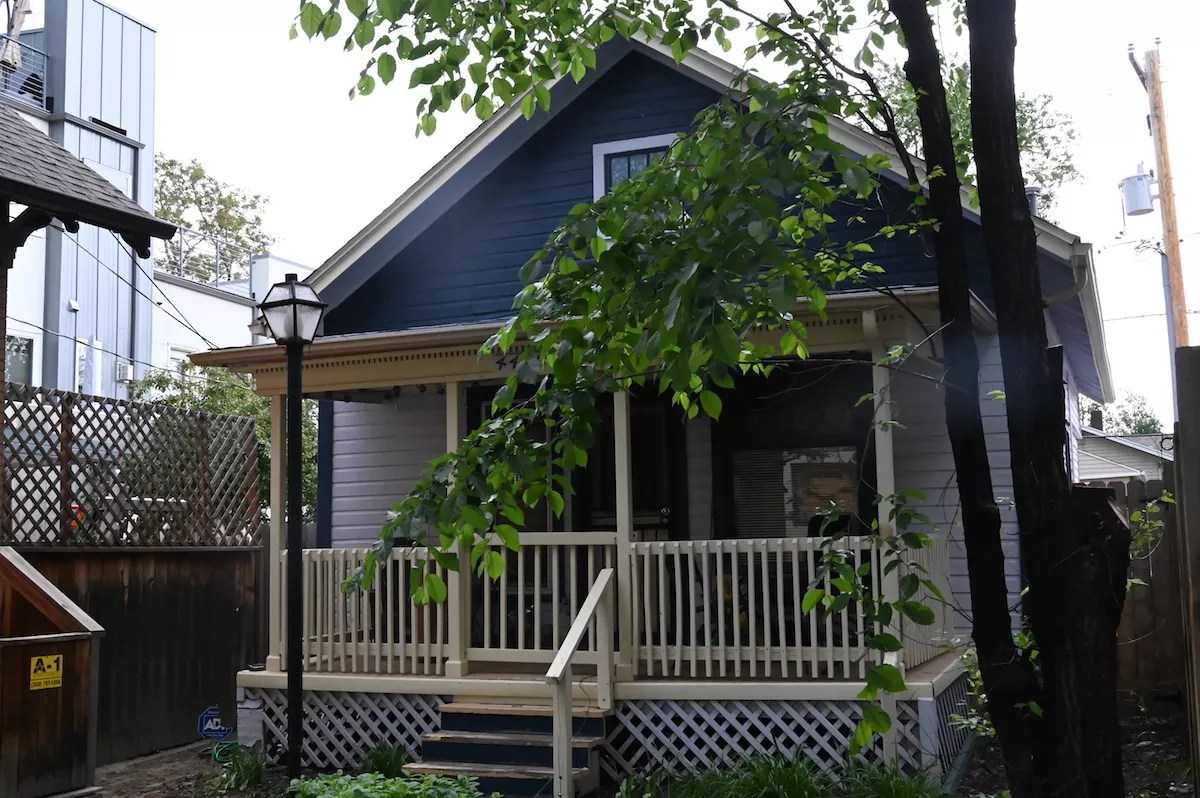
Bennito L. Kelty

Audio By Carbonatix
Homes aren’t built the way they used to be.
In the 4500 block of Tennyson Street, a row of hip, modern townhouses and three-story apartment complexes holds few reminders of what the area was like a century ago, when the Oriental Theater was being built just down the block in the heart of the Berkeley neighborhood in northwest Denver. The original Elitch Gardens was eight blocks down the street; Lakeside Amusement Park was just a mile away.

The house at 4450 Tennyson Street is a reminder of what this neighborhood used to be like.
Bennito L. Kelty
One holdout from that era is the old blue house at 4450 Tennyson Street, which Daphne Salone bought to use as her accounting office in 2006, and today rents out. Next door, there’s another: a circa 1910 red-brick home at 4454 Tennyson – with an “absolutely magnificent” interior with stained glass – owned by Green Door Living Real Estate.
We’re thankful for you. Are you thankful for us?
We feel thankful for our staff and for the privilege of fulfilling our mission to be an unparalleled source of information and insight in Denver. We’re aiming to raise $50,000 by December 31, so we can continue covering what matters most to this community.
Help us continue giving back to Denver.
Salone bought the smaller house for $185,000 when “that whole strip of Tennyson was like crack houses,” she recalls. “No one went up there unless they had to. You never wanted to come down the street because it was really scary.” Now the street is lined with pricey apartments and hip stores.
Salone says she buys houses “like most girls buy shoes.” She bought her first home when she was 24, in Aurora, and then purchased two near Sloan’s Lake before buying 4450 Tennyson. She would like to own 4454 Tennyson, too, and make them both Denver landmarks. But that’s out of her price range.
Instead, she’s focusing on putting her own property on the city’s historic register to protect it from encroaching development. But she knows little about the home’s history beyond the fact that it was built in 1900.
A few years ago, a family stopped by and asked to look around its interior. They said they were the grandchildren of the original builder of both her house and the larger one next door, but “I didn’t think much of it at the time,” she recalls. “I thought, ‘Well, jeez, how hard could it be to get in touch with them in the future if I wanted?”
As it turns out, her house is one of the oldest structures left in the Berkeley neighborhood.
The Oriental Theater, one of the last historic anchors of Tennyson, wasn’t completed until 1927. The carousel that still stands on the old Elitch Gardens grounds was built in 1925, though the park itself was founded in 1890. Both the carousel and the theater are on national historic registers.
People started homesteading the area in the 1860s, according to the Tennyson Berkeley Business Association, and a trolley line was added to its dusty streets only a few decades later. In 1892, the area became the Town of North Denver, but it became the Berkeley neighborhood after it was annexed to Denver in 1902, the year the Colorado Legislature made Denver both a city and a county.

A photo from 1900-1905 looking north from 38th at Tennyson Street with the trolley Elitch car no. 64 and Leyden car no. 68.
Denver Public Library/Western History Collection
As in other Denver neighborhoods on the north and west sides, Italians and Mexicans immigrated to Berkeley in the 1930s and ’40s; along with Sunnyside and Highland, it became part of what was known as the Northside in the ’60s and ’70s.
By the 1990s, the Berkeley neighborhood had lost its trolley line, Elitch Gardens had moved, and mom-and-pop businesses started leaving. In the next decade, the big buildings and businesses started coming in, and Tennyson lost much of its old-neighborhood charm.
Salone’s house is one of the lucky last relics of the historic street’s original character.
“It’s really important for people to walk down the street and look left and say, ‘Oh, my God, what on earth is this?’ Well, guess what, that’s what this whole block used to look like,” Salone says. “I can’t imagine what that would be like to look at a city that’s been basically leveled and rebuilt when there was nothing wrong with what was there in the first place.”
The blue house is almost hidden, pushed back from the street, with a long green lawn stretching from the sidewalk to its short wooden patio and quaint blue facade.
“When you drive by there, you miss my house unless you’re looking for it,” Salone says. “It looks like a shed, a garden shed, it’s so small.”
Dog walkers who pass by the house have at times mistaken the property for a small park and let their pooches run onto the lawn and play, only for the tenant to ask them what they’re doing.
“It’s the only green grass and the only big trees left on the block,” Salone says. “It’s this tiny stretch of lawn, and everyone’s craving it.”
Salone has had offers for the house from developers, including Green Door Living, which owns the properties on both sides. She used to be open to the idea, but now says she wouldn’t sell it to developers “for $1 million.
“My little house, she’s awesome,” Salone says. “My little house is going to be sitting there forever.”
Not only is it “important historically,” she explains, but having it still standing on the block sends a message.
“People are so transient now and so fickle with their homes,” Salone says. “It’s hard to imagine the City of Denver and some of those older streets that could possibly never have one original structure left on them. It just breaks my heart.”